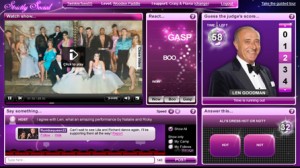Exploring Interactive Narrative – Simultaneous
I had thought that I would be able to conclude the series on interactive narrative with a flourish talking about 2-screen TV, this being the season for reality shows and all. Alas, for reasons known best to the broadcasters, this year’s incarnations of Strictly Come Dancing, The Apprentice and others are bereft of the social media accoutrements that they enjoyed last year.
2-screen TV describes a version of simultaneous narrative that complements and supports ‘live’ events. It is a situation whereby the audience ‘participates’ in a parallel but linked environment. The BBCs’s Apprentice Predictor was typical.
The Apprentice sets Twitter alight every broadcast. The target audience are particularly network-savvy and opinionated.
Recognising that the community already existed, was engaged and vocal, the BBC gave them somewhere to gather – the Predictor website. Although ‘live’ for the duration of the series, the Predictor came into its own during the broadcast with viewers able to comment on the proceedings and in a beautiful playful way, attempt to predict who was going to be fired.
Roo Reynolds wrote about it and included this video clip of the Predictor in action:
Another BBC show, Strictly Come Dancing, created Strictly Social as a vehicle to support simultaneous activity during the broadcast. It provided a structured focus for chat, comments and audience scoring. Comically, it also offered the facility to cheer and boo, virtually.
The fact that the participation wasn’t acknowledged in the broadcast (in any more meaningful way that advertising the existence of the site), let alone influencing the judging did not detract from the audience’s pleasure – it put them in touch with thousands of like-minded individuals to create a unique shared event.
Lots of shows now host simultaneous online communities that chatter away during the broadcast (although one might argue they are not providing anything more than Twitter or Facebook except channel advertising). However, Channel 4’s Seven Days actually allowed users to communicate with the onscreen participants for real. Their ChatNav website offers a direct line to the show’s stars and promises to influence the course of events.
In real life, Twitter has provided a ‘back channel’ for conferences for some time. It enables audiences to discuss the presenter’s current topic in the background. It can be a highly disruptive activity – in both a positive and negative way. At its best, audience comments can be incorporated into the presentation, either in the form of discussion or to help the presenter tailor the talk more appropriately. At its worst, it can fatally undermine the presenter’s talk by damining it with a barrage of criticism.
What all these illustrate is the ability to engage an audience without necessarily offering them any real control but the fellowship of community instead. And that community writes its own story and defines its own narrative.
The whole Interactive Narrative series is:
- Linear narrative
- Parallel narrative
- Non-linear narrative
- Branching narrative
- Dynamic narrative
- Simultaneous narrative
P.S. If anyone can offer an explanation for the premature demise of 2-screen TV from UK broadcasting, please let me know. c



Trackbacks/Pingbacks
[…] This post was mentioned on Twitter by Carlton Reeve, Carlton Reeve. Carlton Reeve said: 2-screen TV – simultaneous narrative from my blog, Play with Learning http://bit.ly/fUAD5H […]
[…] are tremendous opportunities for simultaneous narrative and two-screen experiences but for the time being, television remains the social media. blog […]